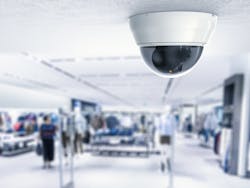This article originally appeared in the April 2020 issue of Security Business magazine. When sharing, don’t forget to mention @SecBusinessMag!
Retailers are continuously challenged with finding ways to reduce and prevent shrink. These businesses are looking for asset protection solutions that will help maintain the safety of their customers and employees, while also combating the massive amounts of loss that occurs each year.
In 2019, retailers suffered nearly $50 billion in shrink, with one-third of that being attributed to employees, resulting in a significant impact on the bottom line. Further complicating the equation is the ongoing health pandemic, presenting material security challenges for businesses and having a huge financial impact on the worldwide economy. That means it is more important than ever in times like these for retailers to have security solutions that will help deter crime, reduce shrink and protect lives.
With the current crisis we are facing, it is more likely that crime – burglaries, robberies, shoplifting and even looting – will likely spike for retailers. They want to know that their security systems are working, that their alarm systems are functioning as they should and that they have quick and easy access to all of their information.
To that end, there are several advanced solutions that security integrators should offer to make a true impact on minimizing retail loss, including monitoring systems, video surveillance, AI and deep learning, and network infrastructure equipment.
Interactive Monitoring Systems
On the safety and security side, interactive monitoring systems with live video and two-way audio have been gaining strength and are playing a critical role. They offer a virtual, guard-like level of protection in the retail environment, offering lightly staffed operations and lone employees’ safety at a fraction of the cost of a live security guard.
With this solution, the security team can see, hear and communicate with employees in retail stores, and can make public announcements during store openings, closings and cash drops – often preventing crime before it happens. Employees can also trigger an alarm if an emergency or suspicious event occurs and get an immediate response from a live person who can assess the situation.
Throughout the day, remote operators conduct virtual guard tours by tapping into live audio and video feeds and checking throughout the store, just as an on-premises security guard might do. At the conclusion of that tour, the operators may then ask the location if all is well and seek an affirmative response from the employees. This makes customers aware that there’s a security presence on hand, creating a safer environment at the location. At the same time, shoplifters and others will think twice before engaging in criminal activity.
Employees can also set off an alarm that is received in the command center through a series of panic devices and direct dial phones. The monitoring center, with the live audio and video, immediately looks into the store and responds to whatever is happening. Interactive monitoring systems create a powerful layer of security, as well as offer a potent way to combat shrink and show a compelling ROI.
Video Surveillance
One of the most powerful and proven ways to reduce internal shrink – most common at the point of sale – is Point of Sale (POS) Exception Reporting integrated with cloud-based video, which enables loss prevention professionals the ability to quickly identify anomalies at the cash register.
This solution provides real-time, actionable intelligence by scanning every register transaction and indicating when a suspicious transaction occurs. The solution sets parameters around problematic and suspicious point of sale transactions for the asset protection teams. When anomalies occur, they are logged and the asset protection team can go into the reports and isolate the most problematic stores, the most problematic transactions and the most problematic employees. From there, tagged video corresponding to the event is easily accessed, enabling the team to view exactly what happened at the register. This cloud-based solution can ultimately result in thousands of dollars in savings per month for the end-user, and it can be remotely hosted and managed by the integrator.
Cloud-based video is making a significant impact in the retail space. Modern asset protection teams are mobile and on the go. Rather than having all critical video stored on-premises on a DVR, cloud-based solutions can push relevant video clips to the cloud for easy access by asset protection teams.
The other big benefit for retailers is the management capability that cloud video provides. For example, if a retailer has hundreds or thousands of cameras and DVRs throughout stores, the administrative features of cloud-based technologies enable them to get reports that indicate if a camera in a store is not recording or if a DVR is showing signs of failure – key information for integrators who are using it as part of a managed service plan.
Another piece of the infrastructure puzzle is storage. An effective solution needs to strike a balance between on-premises storage and limited cloud storage – a balance can be found by using physical or flash hard drive storage on premises to capture most of the end-user’s data and then selectively store actionable portions of video to the cloud.
The data stored in the cloud might include video from motion alerts in key areas or video of POS exception transactions over a certain dollar threshold – giving the end-user easy access to the most critical data.
Advanced Analytics, AI and Facial Recognition
Facial Recognition, a form of artificial intelligence (AI), is a game-changer for the industry, and will enable retailers to better secure their locations and reduce shrink. Integrated into such applications as alarm monitoring and video surveillance, facial recognition will help retail security teams know immediately when a flagged individual enters a location; thus, enabling security staff to respond accordingly.
Beyond facial recognition, other forms of AI that will have a positive impact on the retail industry include behavioral analytics that can process data from various sources – such as video, point of sale and alarm events – and combine those into a database to be assessed by powerful algorithms. AI will eventually be able to determine with certainty if someone is shoplifting and catch them in the act.
The real-time actionable intelligence AI will produce is hard to fathom. To be sure, asset protection teams will have better data to act on, thus making remote interactive monitoring even more effective.
Network Management
Understanding the nexus between network technologies and asset protection technologies is absolutely critical for security integrators who want to thrive in the retail market. Retailers need to ensure that IT and security teams are effectively working together, which necessitates a foundationally strong network solution. If the network is not designed to competently support security applications, retailers are putting themselves in precarious situations.
Integrators must ensure that retailers have adequate network throughput to support video surveillance, and it is essential that all stakeholders understand the interplay between key components such as camera resolution, broadband speed/capacity and storage requirements.
Network segmentation is another key area that is growing in interest from a security perspective. It is not prudent to have mission-critical store applications competing for network capacity. Even with SD-WAN solutions that can prioritize certain types of network traffic, retail IT teams may be hesitant to have video on the same network connection as POS transactions.
We often set up retailers with parallel segmented networks: One for video, alarm and other asset protection-based solutions; and another for store operations and applications, such as credit card processing. It is quite common for stores to have a separate, dedicated network for interactive monitoring services – a solution that demands a robust network – and any other asset protection services. That way, it provides complete demarcation and separation between credit card transactions and the asset protection, while providing a higher level of performance.
Editor’s Note: Read more about network segmentation in this article from Chuck Davis.
Cybersecurity is critical to retailers right now. Just as point of sale transaction data has to be locked down and must comply with PCI requirements, retailers also want to have similar types of protections in place for video. Generally, they want to limit as much inbound access to the network as possible, and, of course, lock-down any video access only to authorized personnel. One way is to keep it on a secure network and protect it with a solid firewall with appropriate cybersecurity protections.
Sean Foley is Senior VP for Interface Security Systems LLC (https://interfacesystems.com), a Missouri-based managed services provider specializing in IT, interactive alarm monitoring, video surveillance and business intelligence. Mr. Foley works with retail, casual dining and quick service restaurant establishments to implement next-generation security strategies.



